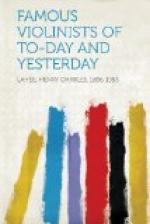In 1854 he went to London and was appointed solo violinist in the queen’s band, but when in 1860 he obtained his amnesty and returned to Hungary he was created solo violinist in the band of the Emperor of Austria.
His restless disposition would not allow him to remain long in one place, and in 1865 he once more began to travel. He visited Paris, where he created a perfect furore, and then continued his triumphant course through Germany, Holland, and Belgium. After settling in Paris for about two years, he returned in 1877 to London, where he repeated his Parisian successes, appearing, as in Paris, chiefly in the salons of wealthy patrons. During this visit to London he appeared in public only once, at Mapleson’s benefit at the Crystal Palace, when he played a fantasia on themes from the “Huguenots.” The following year he went once more to the United States, and on his way played at the promenade concerts in London. In America he remained for some years, and then proceeded in 1887 to the Cape of Good Hope and Madagascar. While on this voyage it was reported that his ship was wrecked and that he was drowned, and numerous obituary notices of him appeared in the newspapers throughout the world.
In 1891 he was once more in London, and played at the house of the late Colonel North, “the Nitrate King.” He now returned to the United States, where he passed the remainder of his days. His powers were, however, failing, and other violinists had brought new and perhaps higher interest to American audiences.
When Remenyi visited the United States in 1878, he arrived a few weeks after Wilhelmj, and notwithstanding the fact that the two violinists were widely different in temperament, ideas, musicianship, in fact in every particular, they were frequently made the subjects of comparison. At this time Remenyi played an “Otello Fantaisie,” “Suwanee River,” “Grandfather’s Clock,” etc. He was well sketched in a journal of the time, which said:
“Remenyi is gifted with a vivacious, generous, rather mocking disposition which rebels against monotony, and whose originality shines through everything, and in spite of everything. He is fluent in five or six languages, and entertains with droll conceits, or with reminiscences of famous artists and composers.... In the wild rhythms of the gypsy dance, in the fierce splendour of the patriotic hymn, the player and audience alike are fired with excitement. The passion rises, the tumult waxes furious; a tremendous sweep of the bow brings the music to an end; and then we can say that we have heard Remenyi.”
The gypsy dance and the patriotic hymn! And yet he was weighed in the balance with Wilhelmj, who played the grandest and best music in the most refined, musicianly manner, and whose tour in America marked an epoch in the musical life of the country.




